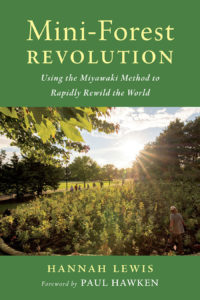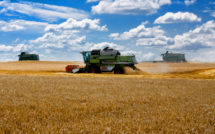
 Mini-Forest Revolution: Using the Miyawaki Method to Rapidly Rewild the World
Mini-Forest Revolution: Using the Miyawaki Method to Rapidly Rewild the World
By Hannah Lewis
Publisher: Chelsea Green Publishing
Recommended by Hélène B. Ducros
Hannah Lewis’s latest book is about rewilding the planet through a reconceptualization and rescaling of the “forest.” In presenting Japanese plant ecologist Akira Miyawaki’s revolutionary method for rejuvenating degraded land into vibrant ecosystems that assist in the struggle against global warming, Lewis approaches the idea of the mini-forest—also called tiny forest, or micro-forest—not only as a reforestation strategy, but as an all-encompassing undertaking that has deep consequences beyond the ecosystems and communities immediately served. Coming of age in Hiroshima after it was bombed and partly trained in Germany, Miyawaki, who died in 2021 at 93 years old, spent decades helping establish thousands of forests all over the world and training other botanists in his technique. In her book, Lewis explains the ways in which he came to the realization that a tiny forest should not simply be an attempt to mimic an old-growth forest at a lesser scale and why planting a “forest” requires a different stance towards ecology than merely “planting trees.” While the idea of mini-forests is not new (Miyawaki first wrote about them in the 1970s), the volume shows how the practice has gathered momentum over the last decade in places such as Paris (France) or London (UK), cities in the Netherlands, Beirut (Lebanon), India, Cameroon, Iran, or the US, as communities increasingly seek to counter urban heat island effects and the general deterioration of their natural environment, manifest, for example, in the disappearance of pollinators or in soil degradation. The book takes readers on a discovery tour of the method and the man behind it, a few recent flagship projects across the world where the method has been applied, and the actors involved at multiple scales—from local schoolchildren, citizen scientists, and civil society associations, to corporations and industrial leaders, city governments, and international organizations. The author also focuses on the symbiotic relationship between water and the sylvan world and how micro-forests provide opportunities for water-poor communities to protect their food crops, as well as how the experience of collectively bonding with a mini-forest project can heal communities that have experienced trauma. Indeed, the Miyawaki method entails much more than planting trees. It is truly about an engagement to plant the future together, a philosophy, as “mini-forests are where we touch life” (xi).
Mini-Forest Revolution reads like an inspiring novel, storybook, travelogue, personal journal, botanical précis, guidebook, project report, and how-to manual all at once. It is a splendid introduction to the Miyawaki method that not only explains the origin of the concept and rationale behind it on an ecosystemic level but also highlights how individuals and communities can directly participate in addressing climate change in a palpable way with short-term results on their immediate physical and social environment. From global cities to local campuses or UNESCO sites (such as the landscape around the Great Wall of China), the Miyawaki method is being adopted worldwide as a reforestation template that requires little time (three years until the mini-forest is established) and little space (the equivalent of six parking spaces) and provides opportunities for transforming non-places (parking lots, lawns, blighted open spaces, or depleted barren lands) into havens of biodiversity and carbon-absorption, heat and noise buffers, green corridors in industrial zones, and shelters for plant, animal, and human communities to thrive. Highly readable, the book also constitutes a practical guide for designing sustainable and stress-resistant mini-forests from scratch, in harmony with places, ecosystems, and the communities of organisms that are present there (including human communities). The book invites readers to seek this opportunity to create and care for a small ecosystem where change occurs on a human spatio-temporal scale. The book will resonate with any scholar or lay person interested in the human-environment nexus, as well as those who wish to practically engage in the process and who will find in this book a guide through tree species identification and selection, planting techniques and early maintenance requirements, as well as ways to involve the community around an environmental pedagogical endeavor that sensitizes people to the exigencies of the pledge to reduce carbon emissions to half of 2010 levels by 2030.
Published on May 18, 2022.




